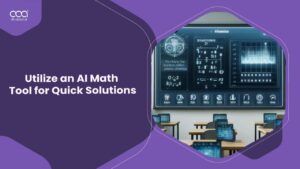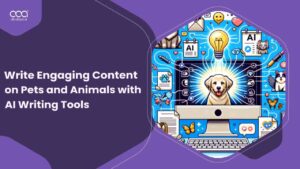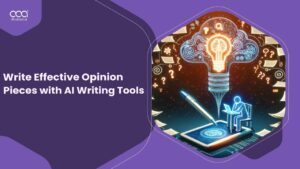In an era where artificial intelligence (AI) is reshaping the contours of various industries, its application in creating user manuals has become a game-changer. As an authority in the intersection of AI technology and technical documentation, I have observed the transformative impact AI can bring to developing user manuals.
The journey of How to Use AI for Writing Effective User Manuals in France is a meticulous process characterized by a series of deliberate steps aimed at harnessing AI’s capabilities to produce manuals that are not just comprehensive but also user-centric and intuitive.
This article is poised to take you through a detailed exploration of each step in using AI to author user manuals that stand out for their clarity, precision, and accessibility.
How To Use AI For Writing Effective User Manuals in France for 2024 – Step By Step Guide
Creating effective user manuals with AI writing tools involves a strategic approach to ensure that the end product is not only informative but also engaging for the user. Here’s a step-by-step guide:
Step 1: Define the Scope and Objectives
Begin by clearly outlining the scope and objectives of your user manual. Understand the key functionalities of your product or service, identify the target audience, and determine what you aim to achieve with the manual. This foundational step ensures that the content created is purposeful and tailored to the needs of the end-user.
Example:
Imagine you’re creating a manual for a smart home thermostat. You decide the manual should help users install the device, connect it to Wi-Fi, troubleshoot common issues, and understand energy-saving features. By defining these objectives, you ensure the manual covers all necessary aspects to provide a comprehensive user guide.

Step 2: Select the Right AI Writing Tool
Research and choose an AI writing tool that best suits your project requirements. Consider factors such as the tool’s technical capability, ease of use, customization options, and compatibility with other software. The right tool will facilitate the creation of a manual that is both comprehensive and understandable to your audience.
Example:
After researching, you select an AI writing tool that specializes in technical documentation and supports custom templates for electronics. This tool can understand complex technical descriptions and convert them into user-friendly instructions, making it ideal for your smart home thermostat manual.
Step 3: Input Detailed Product Information
Provide the AI tool with detailed and accurate information about your product or service. This includes technical specifications, usage instructions, troubleshooting steps, and FAQs. The quality of the AI-generated content heavily relies on the depth and accuracy of the information provided.
Example:
You input detailed specifications of the thermostat, including model variations, hardware specs, installation procedures, and common troubleshooting steps. This ensures the AI tool has a rich dataset to generate accurate and relevant sections of the manual.

Step 4: Customize AI Settings for Your Audience
Tailor the AI tool’s settings to ensure the content’s tone, style, and complexity are appropriate for your target audience. Customization is key to making the manual accessible and engaging for users, whether they are novices or experts in the field.
Example:
Knowing your target users are not all tech-savvy, you adjust the AI tool to use layman’s terms and avoid technical jargon. You aim for a friendly and reassuring tone to encourage users to read and follow the manual confidently.

Step 5: Generate the First Draft
This is one of the most crucial step when understanding how to use AI for writing effective user manuals in France. Utilize the AI tool to generate an initial draft of your manual. This draft should encompass all the necessary information structured in a logical and user-friendly manner. It serves as a starting point for further refinement and personalization.
Example:
Using the AI tool, you generate a draft that includes sections on installation, Wi-Fi setup, daily use, troubleshooting, and energy-saving tips. This draft organizes the information logically, starting from setup to advanced features, ensuring a smooth flow for readers.

Step 6: Review and Refine the Content
Manually review the AI-generated draft to ensure its accuracy, clarity, and completeness. This step is crucial for identifying areas that require adjustments or further detail, ensuring the manual meets the highest standards of quality.
Example:
Upon reviewing the draft, you notice the troubleshooting section lacks detail on resolving Wi-Fi connectivity issues. You manually add more specific steps and tips, ensuring users can easily solve common problems without needing further assistance.
Step 7: Incorporate Visual Elements
Enhance the manual with appropriate visual elements such as images, diagrams, and videos. These elements can significantly improve the user’s understanding and retention of the information presented. Some AI tools may also assist in creating or suggesting visuals that complement the text.
Example:
You decide to add diagrams for the installation process, screenshots for the app setup, and icons to highlight energy-saving tips. For the Wi-Fi troubleshooting section, you include a flowchart. These visuals are designed to complement the AI-generated text, making complex instructions easier to understand.

Step 8: Test the User Manual with Real Users
The 8th step of how to use AI for writing effective user manuals in France is to conduct usability testing with a sample of your target audience to gather feedback on the manual’s effectiveness and clarity. This feedback is invaluable for identifying areas for improvement and ensuring the manual adequately supports users in understanding and using your product or service.
Example:
You gather a small group of users with varying levels of technical expertise to use the manual and set up their thermostat. Feedback indicates that the energy-saving tips section is highly appreciated, but the Wi-Fi setup instructions are a bit confusing. This feedback highlights areas for improvement.
Step 9: Revise Based on Feedback
Use the insights gained from user testing to refine the manual further. Make necessary revisions to address any issues or confusion identified, ensuring the manual is as clear and helpful as possible.
Example:
Based on user feedback, you simplify the Wi-Fi setup instructions and add a QR code that links to an online setup video. You also enhance the energy-saving tips section with additional practical examples, making the manual more user-friendly and helpful.
Step 10: Finalize and Publish
After thorough revision and ensuring all feedback has been addressed, finalize the manual for publication. Choose the appropriate formats and distribution channels to ensure they reach your intended audience effectively.
Example:
After revisions, you finalize the manual and publish it in PDF format on the product website. You also include a printed version in the product packaging and ensure the online version is mobile-friendly, making it accessible to all users.
Step 11: Monitor and Update Regularly
The last step in understanding how to use AI for writing effective user manuals in France is to stay responsive to user feedback and product updates and regularly revise the manual to reflect any changes. Keeping the manual up-to-date is crucial for maintaining its usefulness and relevance to users.
Example:
Six months later, the thermostat receives a firmware update that introduces new features. You update the manual to include these features, using the AI tool to generate new sections. You then publish the updated manual online, ensuring users have access to the latest information.
What are the Best AI Tools for Creating User Manuals?
In the pursuit of crafting effective user manuals, several AI tools stand out for their capabilities in streamlining the documentation process. Below, I have explained three leading AI tools Jasper AI, ChatGPT, and Scribee, and how each can be harnessed to create user manuals that are not just informative but also engaging and user-friendly.
Jasper AI
Jasper AI specializes in content creation and is designed to understand context and generate text that is coherent, relevant, and tailored to specific needs. For writing user manuals, Jasper AI can be an invaluable asset due to its ability to produce clear, concise, and technically accurate content.
Here’s how you can use Jasper AI:

Content Generation:
Input detailed product information, including features, benefits, and technical specifications, and Jasper AI can generate sections of your manual, from introductory explanations to detailed instructions.
Tone Customization:
Jasper allows you to customize the tone of the content, ensuring the manual is approachable and understandable by your target audience, whether they are tech-savvy users or novices.
Efficiency:
With Jasper AI, you can significantly speed up the manual creation process, producing drafts quickly that can then be refined and edited for precision and clarity.
ChatGPT
ChatGPT, developed by OpenAI, is a powerful language model capable of understanding and generating human-like text based on the input it receives. Its adaptability makes it suitable for a wide range of content creation tasks, including user manuals. Here’s how ChatGPT can be leveraged:

Interactive Writing Assistance:
You can conversationally interact with ChatGPT to draft sections of your manual. By asking questions or providing prompts about specific features or troubleshooting steps, ChatGPT can generate relevant content that can be directly used or easily edited.
Customization and Scalability:
ChatGPT can tailor its output to match the complexity and style needed for your audience. Whether you’re creating a simple guide or a detailed technical document, ChatGPT can adjust its responses accordingly.
Knowledge Integration:
ChatGPT can incorporate a wide range of information into the manual, ensuring that it is comprehensive and informative. It can also suggest content improvements or additions based on its training, enhancing the manual’s overall quality.
Scribe
Scribe is a unique tool for exploring AI-driven documentation, focusing on the automatic generation of step-by-step guides. It’s particularly useful for user manuals that involve software or digital products. Here’s how Scribe stands out:

Automated Process Documentation:
Scribe can capture screen actions as you perform tasks on a computer, automatically generating step-by-step guides complete with screenshots. This is ideal for creating tutorials or walkthroughs for software applications.
Ease of Use:
With minimal input, Scribe creates clear, concise, and visually appealing guides. This simplifies the process of documenting complex tasks, making it easier for users to follow along.
Customization:
Though Scribe automates much of the documentation process, the output can be customized. You can edit the text, add additional notes, and tailor the instructions to ensure they meet the user’s needs precisely.
Each of these AI tools offers unique features and capabilities that can be utilized to write effective user manuals.
Jasper AI excels in generating coherent and tailored content quickly, ChatGPT offers conversational interaction and scalability for a variety of documentation styles, and Scribe is unparalleled in creating visual, step-by-step guides for software-related tasks.
By leveraging these tools, you can streamline the manual creation process, ensuring that your documentation is not only comprehensive but also accessible and engaging for your target audience.
Exploring Types of User Manuals and Their AI Applications
In the context of leveraging artificial intelligence to enhance documentation processes, understanding the various types of user manuals and how AI can be applied to each is crucial. AI tools have the potential to revolutionize the way we create and interact with user manuals, offering personalized, efficient, and dynamic solutions.
Below, I have explored different types of user manuals and pinpointed how AI technologies can be uniquely applied to improve their creation and utility.

Quick Start Guides:
These manuals provide concise instructions to get a user started with a product or service. AI can generate clear, straightforward steps tailored to the novice user, ensuring a seamless initial experience.
Troubleshooting Manuals:
Aimed at helping users solve common problems, AI can analyze user feedback and support tickets to identify and update troubleshooting guides with the most relevant solutions over time.
Technical Manuals:
These documents contain detailed information on the product’s specifications, settings, and functionalities. AI can assist in drafting complex technical content that is both accurate and accessible to the intended audience.
Software Documentation:
For software applications, these manuals include installation guides, feature explanations, and usage tips. AI tools like Scribe can automatically capture and document software processes, creating step-by-step tutorials with ease.
Policy and Procedure Manuals:
These outline the rules and guidelines within an organization or for a product use. AI can help organize and update these documents as policies evolve, ensuring they are always current and compliant.
Maintenance Manuals:
Essential for products requiring regular upkeep, AI can predict and update maintenance schedules based on usage patterns and feedback, providing users with timely and personalized advice.
Training Manuals:
Designed to educate new users or employees, AI can customize training content to match the learner’s pace and understanding, making education more effective and engaging.
Each type of user manual benefits uniquely from AI applications, from automating content generation and updates to personalizing user experiences.
By integrating AI and natural language processing into the creation and maintenance of these documents, organizations can significantly enhance their effectiveness, ensuring that manuals are not only informative but also adaptive and user-friendly.
Key Features of Effective User Manuals with AI Integration
The integration of AI into user manuals represents a significant advancement in how we provide guidance and support to users. A good user manual with AI integration not only delivers information effectively but also enhances user interaction, making the learning process more intuitive and personalized. Here are the crucial features that define the effectiveness of user manuals in the era of AI technology:

User-Centric Design:
AI-driven manuals are tailored to the user’s understanding level and preferences, providing a personalized experience that can dynamically adjust content based on user interaction and feedback.
Clear and Concise Language:
Utilizing AI to optimize language for clarity and accessibility ensures that information is easy to understand, regardless of the user’s technical expertise.
Interactive Elements:
Incorporating AI-powered chatbots or interactive FAQs within manuals offers real-time assistance, making it easier for users to find solutions and information relevant to their specific issues.
Up-to-Date Information:
AI integration allows for the continuous update of manuals based on new data, user feedback, and product updates, ensuring that the content remains accurate and relevant.
Visual Aids and Demonstrations:
Leveraging AI to generate or suggest visual aids, such as diagrams, videos, and infographics, enhances understanding and retention of complex information.
Searchability and Navigation:
AI enhancements can improve the searchability of manuals, enabling users to quickly find the information they need through natural language queries or intuitive navigation features.
Feedback Loop for Improvement:
AI algorithms can analyze user interactions and feedback to identify areas of improvement, continuously refining the manual to better meet user needs.
Accessibility Features:
AI can help ensure that manuals are accessible to all users, including those with disabilities, by adapting the content presentation to various formats and assisting technologies.
Incorporating these features into user manuals through AI integration not only improves the usability and effectiveness of these documents but also significantly enhances the overall user experience.
As technology continues to evolve, the potential for AI to transform traditional manuals into dynamic, interactive, and highly personalized resources is immense, setting a new standard for how we support and engage with users.
FAQs
Can AI write a user manual?
What is the AI tool for creating user guides?
Can ChatGPT write a training manual?
How to make a manual online?
Conclusion
The role of artificial intelligence in the process of how to use AI for writing effective user manuals in France is transformative, bridging the gap between complex technical documentation and user-friendly guides.
Through AI, we achieve not only efficiency and precision in manual creation but also a level of engagement and personalization previously unattainable so that you can edit and refine your manuals efficiently. As we progress further into the digital era, leveraging AI for this purpose is not just innovative; it’s essential for staying ahead in providing clear, accessible support to users across various platforms.
I urge readers to explore the potential of AI tools in the world of how to use AI for writing effective user manuals in France. These advanced technologies are pivotal in revolutionizing how we convey information, ensuring manuals are not only informative but also tailored to the unique needs of each user.
For further exploration into maximizing the benefits of AI in documentation, I invite you to peruse our how-to blog page, explore our AI tools reviews and the best section of AI tools, and expand your knowledge with my AI glossary. Incorporating AI in the creation of user manuals is a step towards setting new standards in user support and documentation.





